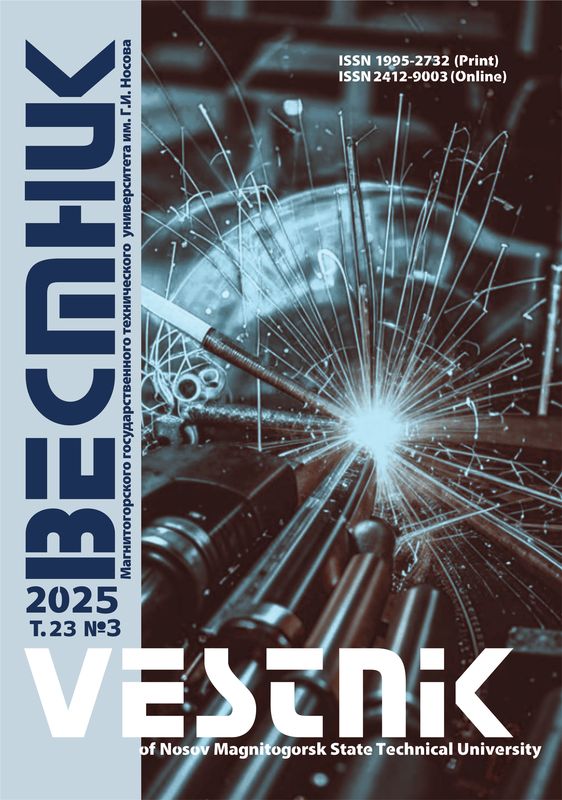Abstract
Problem Statement (Relevance): An urgent task of rolling mill operators includes minimizing the cost of manufactured products while ensuring the required quality. To accomplish the task, measures are being taken to optimize the rolling process aimed at increasing the duration of the rolling campaigns and reducing the number of roll regrinds. The performance of the rolls is influenced by the properties of the working layer material which determine wear resistance, formation and development of fire cracks, as well as resistance to metal sticking. Finishing mill rolls dictate the surface quality of the rolled steel. That is why it is important to make timely regrinds in order to completely remove the fire crack layer. The removal depth and the acceptable duration of the campaigns depend on the properties of the roll working layer material. To improve the properties of the rolls, the roll manufacturers need the actual roll operation data to be able to analyze how the chemical composition and the structure of the roll working layer is related to the roll performance. Such analysis will help improve the structure and properties of the materials used, as well as develop new ones. Objectives: The objective of this research is to understand how the chemical composition of the working layer of indefinite chilled cast iron rolls used in finishing mills dictates the roll performance, to evaluate the effect of each chemical element, and to determine what concentrations of the chemical elements could most effectively benefit the performance of indefinite chilled cast iron rolls. Methods Applied: The methods applied include building a database of the finishing mill indefinite chilled cast iron rolls and using artificial neural networks based on a dual-function algorithm. Originality: The authors built a neuromodel which can help understand the effect of the chemical composition of the roll working layer and predict the performance of indefinite chilled cast iron rolls. The authors studied the effect of carbon, silicon, manganese, chromium, nickel, molybdenum, vanadium, niobium and boron on the performance of indefinite chilled cast iron rolls. Findings: Graphic diagrams were built which demonstrate the effect of each chemical element on the performance of indefinite chilled cast iron rolls at constant concentrations of the remaining elements. The authors looked at the relationship between the chemical elements and the roll performance in terms of the impact of the former on the structure of indefinite chilled cast iron rolls. The effective concentrations of the chemical elements were also determined. Practical Relevance: The authors developed a new chemical composition of indefinite chilled cast iron to be used for the working layer of finishing mill rolls. As a result, a 12–14% increase in the roll performance was achieved.
Keywords
Mill rolls, indefinite chilled cast iron, chemical composition, effect, performance, wear resistance.
1. Pritomanova M.I., Vyshinskaya L.R. The effect of silicon on volume changes in thermal cycling of graphitized alloys. Struktura i svoystva chuguna i stali. Nauchnyye trudy [Structure and properties of cast iron and steel. Research papers]. Vol. 26. Ed. by K.P. Bunin. Moscow: Metallurgiya, 1967, pp. 159–168.
2. Spravochnik po chugunnomu lityu [Handbook in iron casting]. Ed. by N.G. Girshovich. 3rd ed. Leningrad: Mashinostroenie, 1978, 758 p.
3. Gimaletdinov R.Kh., Gulakov A.A., Tukhvatulin I.Kh. Influence of chemical composition on the properties of the working layer of centrifugal cast indefinite chill rolls. Vestnik Magnitogorskogo gosudarstvennogo tehnicheskogo universiteta im. G.I. Nosova [Vestnik of Nosov Magnitogorsk State Technical University], 2016, vol. 14, no. 3, pp. 78–89.
4. Belov V.D., Vdovin K.N., Kolokoltsev V.M., Kovalevich E.V., Ten E.B., Ri Khosen, Ri E.Kh. Proizvodstvo chugunnykh otlivok [Production of iron castings]. Ed. by V.M. Kolokoltsev and Ri Khosen. 2nd ed. Magnitogorsk: Publishing House of Nosov Magnitogorsk State Technical University, 2011, 521 p.
5. Popov V.S., Vasilenko G.I., Nagornyy P.L. Abrasive wear of some high-carbon alloys. Metallovedenie i termicheskaya obrabotka metallov [Physical metallurgy and heat treatment of metals], 1970, no. 5, pp. 47–48.
6. Freeman R. B. The Relative Wear of Some Hard Metals. Metal Progress, 1937, vol. 31, pp. 281–284.
7. Hirsch W. F. Nickel-Boron Cast Iron for Resistance to Abrasion. Metal Progress, 1938, vol. 34, pp. 230–232.
8. Bor, kaltsiy, niobiy i tsirkoniy v chugune i stali [Boron, calcium, niobium and zirconium in iron and steel]. Translated from English by V.A. Mchedlishvili and V.V. Khovrin. Ed. by S.M. Vinarov. Moscow: GNTI ChTsM, 1961, 460 p.












